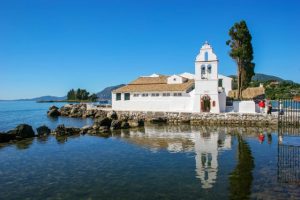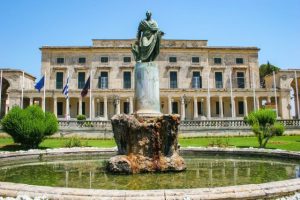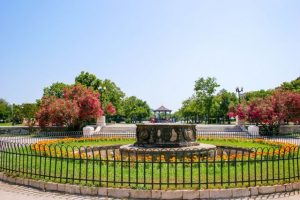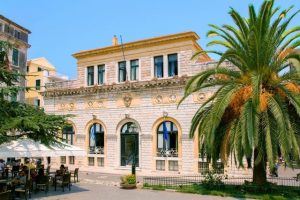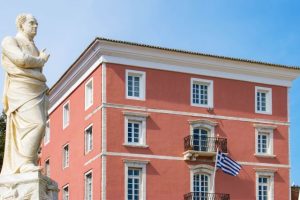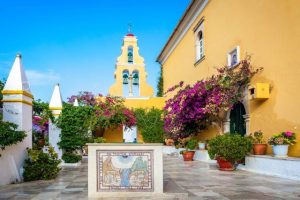About Corfu
About Corfu
Corfu, known as Kerkyra in Greek, owes its name to the Nymph Korkyra, the daughter of the River God, Asopus. According to the myth, Poseidon, God of the Sea, fell in love with Nymph Korkyra, kidnapped her and brought her to this island. Corfu was the island of the Phaeacians, where Odysseus was cast up during his return trip to Ithaca.
Archaeological excavations have proved that the island was inhabited since the Paleolithic Era. In ancient times, Corfu was a very important commercial center inhabited by the Phoenicians. There was trading with all the towns of the Adriatic Sea, making Corfu a strong naval power and an important colonial town, known today as Paleopolis. The ruins of this ancient town are found right opposite the Mon Repos Palace in Corfu Town. Some ancient temples have also been excavated around the island, such as the temple of Artemis.
During the Peloponnesian War, Corfu asked the Athenians for military help for a major battle against Corinth. The alliance between Corfu and Athens lasted for a century, until the Macedonians (under the rule of King Philip II), having won a great battle, conquered Corfu in 338 BC and took control of the island. From 300 BC, Corfu was successively attacked and conquered by Spartans, Illyrians, and Romans, who stayed on the island from 229 BC to 337 AD. During Roman times, the island was allowed to keep part of its autonomy and, in return, the Romans could use the port of the town.
The Roman contribution to the island included roads and public buildings including bathhouses. In 40 AD, Jason and Sossipatros, two disciples of Saint Paul, brought Christianity to the island and built the first Christian church which they dedicated to Saint Stephan on Vidos islet
With the split of the Roman Empire, Corfu united with the Eastern Roman Empire. During the Medieval era, the island was regularly subject to pirate raids and to attacks from barbarians, Goths, or Saracens. Many towers were built to protect the island, such as the Kassiopi Tower. Then Corfu came under Norman rule, followed by Venetians, who marked a prosperous period in the history of Corfu.
In 1267, Charles of Anjou, French King of Sicily, took the island and attempted to replace the existing Orthodox religion with the Catholic one. Orthodox Christians were persecuted and all churches converted to Catholic churches. But the attempt of conversion fell and Corfu returned under Venetian rule in 1386. Corfu stayed under Venetian domination for a long period of four centuries during which a large number of buildings, monuments, and other constructions were built becoming the symbols of Venetian architecture in Greece.
Insurrections were exploding because of the exploitation of the nobles but were severely repressed. Napoleon Bonaparte conquered Venice and, in 1797, Corfu became part of the French State. Napoleon came as a liberator and publicly burnt the Libro d’Oro (Golden Book), which was the book enumerating the privileges of the Nobles. In 1799, the allied fleet of the Turks, the Russians, and the English disembarked on the island of Corfu. After killing the inhabitants of Mandouki in the port, they conquered the entire island.
The Ionian State was established from Constantinople in order to create the Septinsular Republic but the attempt failed and, in 1807, Corfu returned under French domination. The period that followed was a period of prosperity with many agricultural and social improvements. It was then that the Ionian Academy was founded, public services were reorganized and schools were built.
In parallel, the British began to occupy the Ionian Islands and reached Corfu in 1815, which they dominated. The period of English rule was a prosperous period for Corfu because the Greek language became official, new roads were built, the water supply system was improved and the first Greek University was founded in 1824. Although Corfu was never under the control of the Turks, its inhabitants helped the rest of Greece financially during the Greek Revolution. On the 21st of May, 1864, the Ionian Islands were donated by the British to the new King of Greece, George I, annexed to the modern Greek state and have been an official part of it ever since.
In the 20th century, Corfu took part in the two World Wars and suffered great damage. In fact, the Ionian Academy, the Public Library and the Municipal Theatre were burnt and totally destroyed by German bombing in 1943 but they were then restored.
The island had a hard time during the first half of the century, yet the locals managed to exploit the excellent climate and fertile land and give impetus to the economic development of their place.
For more details about exploring Corfu furthermore, you can guide through the following options:

